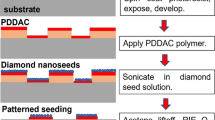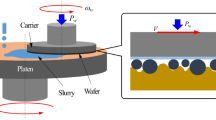Abstract
Tetramethylammonium hydroxide (TMAH) is one of the most commonly used anisotropic etchants in silicon wet bulk micromachining. It has outstanding etching characteristics such as compatibility with semiconductor processes and provides high etch selectivity between silicon and silicon dioxide. In this work, we have investigated the effect of surfactant concentration ranging from 20 ppb to 1000 ppm on the etching characteristics of 25 wt% TMAH for bulk micromachining of Si{100} and Si{110}. Triton X-100 with formula C14H22O(C2H4O)n, where n = 9–10, is used as surfactant. The major objective of this work is to determine the surfactant concentration at which the etch rate, etched surface morphology and convex corner undercutting are significantly affected. Undercutting length and etched depth are measured using 3D scanning optical microscope. Surface morphology of etched silicon samples are inspected using scanning electron microscope. The surfactant concentration below 100 ppb does not affect etching characteristics significantly, while the effect of surfactant concentration above 100 ppb is substantial on the undercutting at convex corners on Si{100} surface, etch rate and etched surface roughness of Si{110}. The etch rate and etched surface morphology of Si{100} are not influenced considerably when the surfactant is added into 25 wt% TMAH.








Similar content being viewed by others
References
Baum T, Schiffrin DJ (1997) AFM study of surface finish improvement by ultrasound in the anisotropic etching of Si{100} in KOH for micromachining applications. J Micromech Microeng 4:338–342
Chen PH, Peng HY, Hsieh CM, Chyu MK (2001) The characteristic behavior of TMAH water solution for anisotropic etching on both silicon substrate and SiO2 layer. Sens Actuators, A 93:132–137
Chen Q, Fang J, Ji H-F, Varahramyan K (2007) Fabrication of SiO2 microcantilever using isotropic etching with ICP. IEEE Sens J 7:1632–1638
Cheng D, Gosalvez MA, Hori T, Sato K, Shikida M (2006) Improvement in smoothness of anisotropically etched silicon surfaces: effects of surfactant and TMAH concentrations. Sens Actuators, A 125:415–421
Dutta S, Imran Md, Kumar P, Pal R, Datta P, Chatterjee R (2011) Comparison of etch characteristics of KOH, TMAH and EDP for bulk micromachining of silicon (110). Microsyst Technol 17:1621–1628
Gosalvez MA, Tang B, Pal P, Sato K, Kimura Y, Ishibashi K (2009) Orientation and concentration dependent surfactant adsorption on silicon in aqueous alkaline solutions: explaining the changes in the etch rate, roughness and undercutting for MEMS applications. J Micromech Microeng 19(12):125011 (18 pp)
Gosalvez MA, Pal P, Tang B, Sato K (2010) Atomistic mechanism for the macroscopic effects induced by small additions of surfactants to alkaline etching solutions. Sens Actuators, A 157:91–95
Gosalvez MA, Pal P, Ferrando N, Hida H, Sato K (2011) Experimental procurement of the complete 3D etch rate distribution of Si in anisotropic etchants based on vertically micromachined wagon wheel samples. J Micromech Microeng 21:125007 (14 pp)
Jeon JS, Raghavan S, Sperline RP (1995) Behavior of polyethylene oxide based nonionic surfactants in silicon processing using alkaline solutions. J Electrochem Soc 142:621–627
Pal P, Sato K (2010) Fabrication methods based on wet etching process for the realization of silicon MEMS structures with new shapes. Microsyst Technol 16:1165–1174
Pal P, Sato K (2015) A comprehensive review on convex and concave corners in silicon bulk micromachining based on anisotropic wet chemical etching. Micro Nano Syst Lett 3:1–42
Pal P, Singh SS (2013) A simple and robust model to explain convex corner undercutting in wet bulk micromachining. Micro Nano Syst Lett 1:1–6
Pal P, Sato K, Gosalvez MA, Shikida M (2007a) Study of rounded concave and sharp edge convex corners undercutting in CMOS compatible anisotropic etchants. J Micromech Microeng 17:2299–2307
Pal P, Sato K, Chandra S (2007b) Fabrication techniques of convex corners in a (100)-silicon wafer using bulk micromachining: a review. J Micromech Microeng 17:R1–R23
Pal P, Sato K, Shikida M, Gosalvez MA (2009a) Study of corner compensating structures and fabrication of various shapes of MEMS structures in pure and surfactant added TMAH. Sens Actuators, A 154(2):192–203
Pal P, Sato K, Gosalvez MA, Kimura Y, Ishibashi K, Niwano M, Hida H, Tang B, Itoh S (2009b) Surfactant adsorption on single crystal silicon surfaces in TMAH solution: orientation-dependent adsorption detected by in situ infra-red spectroscopy. J Microelectromech Syst 18:1345–1356
Pal P, Gosalvez MA, Sato K (2010) Silicon micromachining based on surfactant-added tetramethyl ammonium hydroxide: etching mechanism and advanced application. Jpn J Appl Phys 49:056702 (9 pages)
Pal P, Sato K, Gosalvez MA (2012) Etched profile control in anisotropic etching of silicon by TMAH + Triton. J Micromech Microeng 22(6):065013 (9 pp)
Pal P, Ashok A, Haldar S, Xing Y, Sato K (2015) Anisotropic etching in low concentration KOH: effects of surfactant concentration. Micro Nano Lett 10(4):224–228
Paria S, Khilar KC (2004) A review on experimental studies of surfactant adsorption at the hydrophilic solid-water interface. Adv Colloid Interface Sci 110:75–95
Peng L, Xinxin L, Guomin Z, Jian L, Yuelin W, Min L, Dazhong J (2006) Silicon dioxide microcantilever with piezoresistive element integrated for portable ultraresoluble gaseous detection. Appl Phys Lett 89: 074104 (3 pp)
Resnik D, Vrtacnik D, Aljancic U, Mozek M, Amon S (2005) The role of Triton surfactant in anisotropic etching of 110 reflective planes on (100) silicon. J Micromech Microeng 15:1174–1183
Rola KP, Zubel I (2013) Triton surfactant as an additive to KOH silicon etchant. J Microelectromech Syst 22:1373–1382
Rola KP, Ptasinski K, Zakrzewski A, Zubel I (2014) Silicon 45º micromirrors fabricated by etching in alkaline solutions with organic additives. Microsyst Technol 20:221–226
Sarro PM, Brida D, van der Vlist W, Brida S (2000) Effect of surfactant on surface quality of silicon microstructures etched in saturated TMAHW solutions. Sens Actuators A 85:340–345
Seidel H, Csepregi L, Heuberger A, Baumgartel H (1990) Anisotropic etching of crystalline silicon in alkaline solutions I: orientation dependence and behavior of passivation layers. J Electrochem Soc 137:3612–3626
Sekimura M (1999) Anisotropic etching of surfactant-added TMAH solution. In: Proc. 12th IEEE Micro-Electro-Mech. Syst. Conf., Orlando, Florida, pp 650–655
Shikida M, Sato K, Tokoro K, Uchikawa D (2000) Difference in anisotropic etching properties of KOH and TMAH solutions. Sens Actuators, A 80:179–188
Smiljanic MM, Jovic V, Lazic Z (2012) Maskless convex corner compensation technique on a (100) silicon substrate in a 25 wt% TMAH water solution. J Micromech Microeng 22:115011 (11 pp)
Tabata O, Asahi R, Funabashi H, Shimaoka K, Sugiyama S (1992) Anisotropic etching of silicon in TMAH solutions. Sens Actuators, A 34:51–57
Tanaka H, Umeki N, Sato K (2013) Perfect adsorption of ppb-level surfactant in 5% KOH water solution on a silicon surface changing anisotropic etching properties. In: 17th International Conference on Solid-State Sensors, Actuators and Microsystems (Transducers & Eurosensors XXVII, Barcelona, Spain, 16–20 June 2013) pp 1978–1981
Tang Y, Ji Fang, Yan X, Ji H-F (2004) Fabrication and characterization of SiO2 microcantilever for microsensor application. Sens Actuators, B 97:109–113
Tang B, Pal P, Gosalvez MA, Shikida M, Sato K, Amakawa H, Itoh S (2009) Ellipsometry study of the adsorbed surfactant thickness on Si{110} and Si{100} and the effect of pre-adsorbed surfactant layer on etching characteristics in TMAH. Sens Actuators, A 156:334–341
Tang B, Sato K, Zhang D, Cheng Y (2014) Fast Si (100) etching with a smooth surface near the boiling temperature in surfactant-modified tetramethylammonium hydroxide solutions. Micro Nano Lett 9(9):582–584
Xu YW, Michael A, Kwok CY (2011) Formation of ultra-smooth 45º micromirror on (100) silicon with low concentration TMAH and surfactant: techniques for enlarging the truly 45º portion. Sens Actuators, A 166:164–171
Yang CR, Yang CH, Chen PY (2005) Study on anisotropic silicon etching characteristics in various surfactant-added tetramethylammonium hydroxide water solutions. J Micromech Microeng 15:2028–2037
Zubel I, Kramkowska M (2001) The effect of isopropyl alcohol on etching rate and roughness of (100) Si surface etched in KOH and TMAH solutions. Sens Actuators, A 93:138–147
Zubel I, Kramkowska M, Rola K (2012) Silicon anisotropic etching in TMAH solutions containing alcohol and surfactant additives. Sens Actuators, A 178:126–135
Acknowledgments
This work was supported by research grant from the Department of Science and Technology (Project No. SR/S3/MERC/072/2011) and the Council of Scientific and Industrial Research (CSIR, Ref: 03(1320)/14/EMR-II), New Delhi, India.
Author information
Authors and Affiliations
Corresponding author
Rights and permissions
About this article
Cite this article
Ashok, A., Pal, P. Silicon micromachining in 25 wt% TMAH without and with surfactant concentrations ranging from ppb to ppm. Microsyst Technol 23, 47–54 (2017). https://doi.org/10.1007/s00542-015-2699-9
Received:
Accepted:
Published:
Issue Date:
DOI: https://doi.org/10.1007/s00542-015-2699-9




